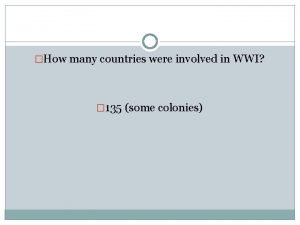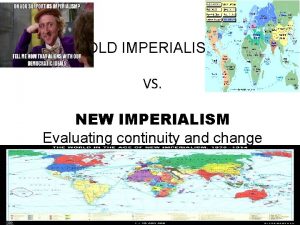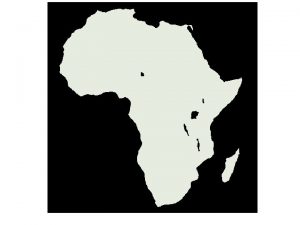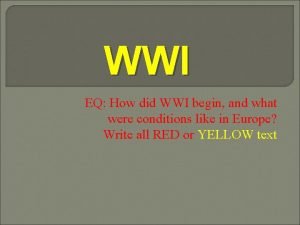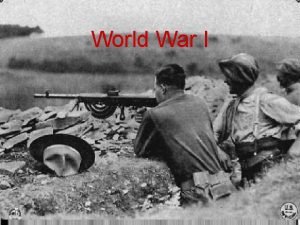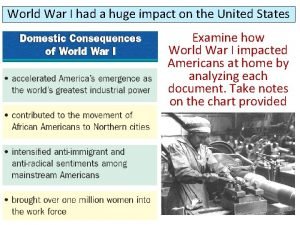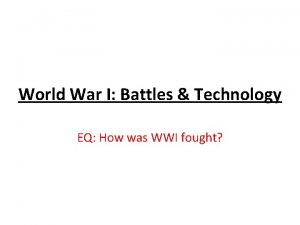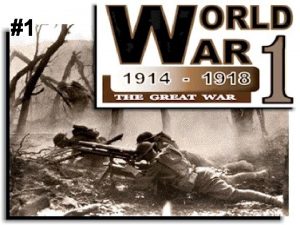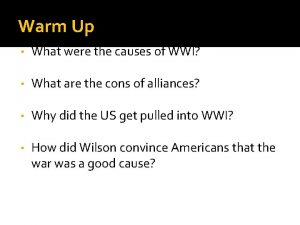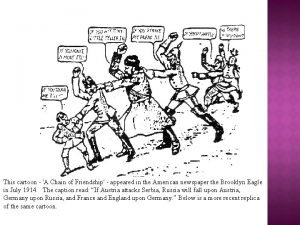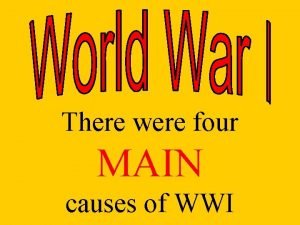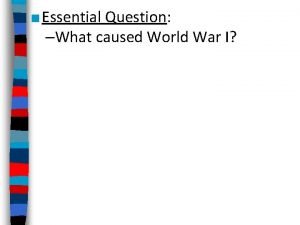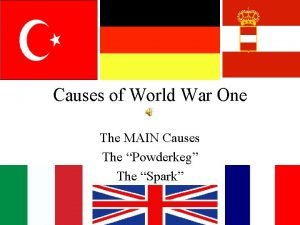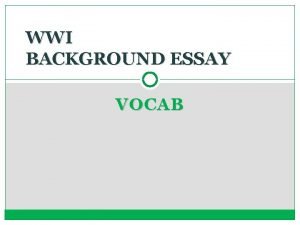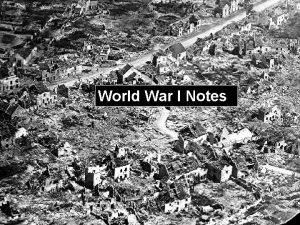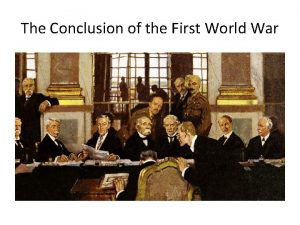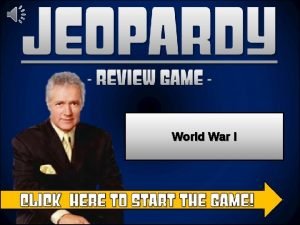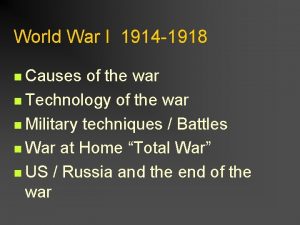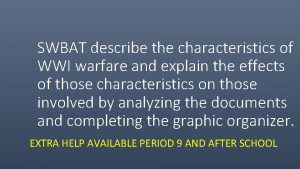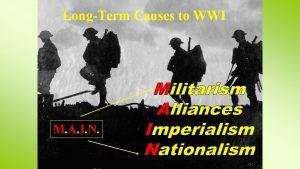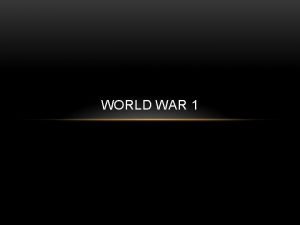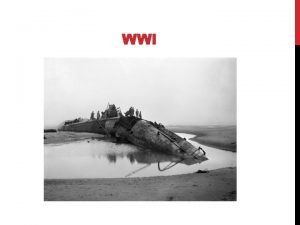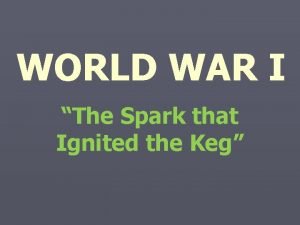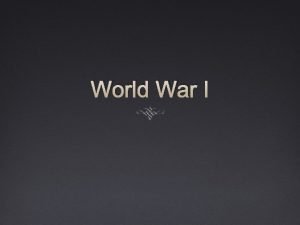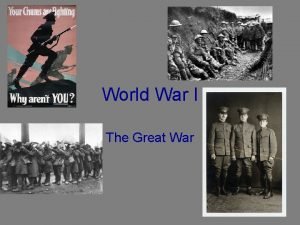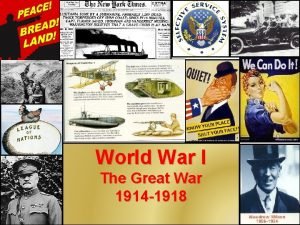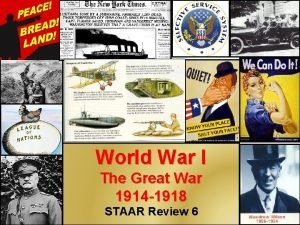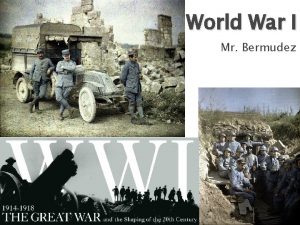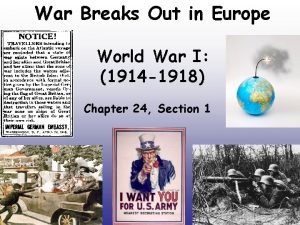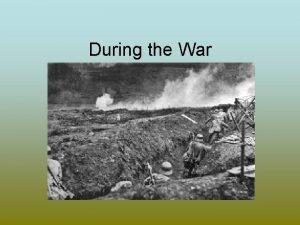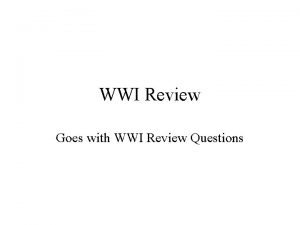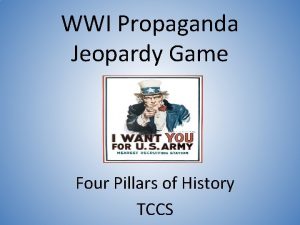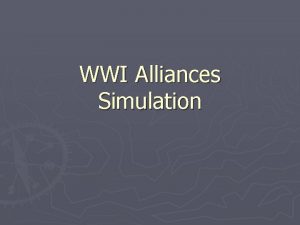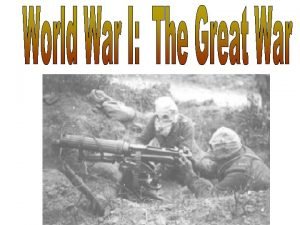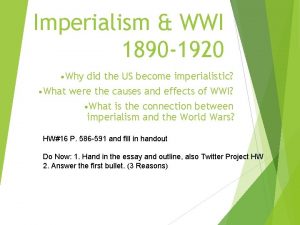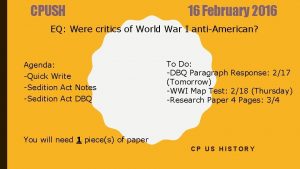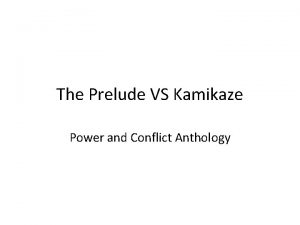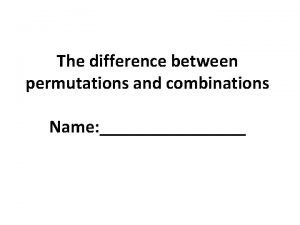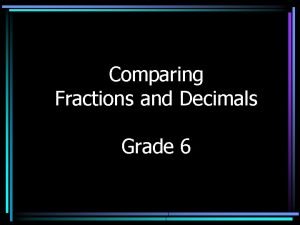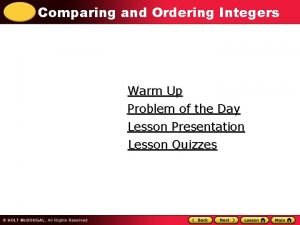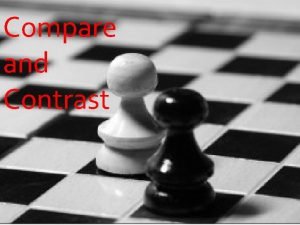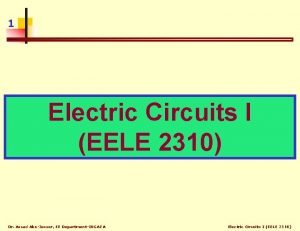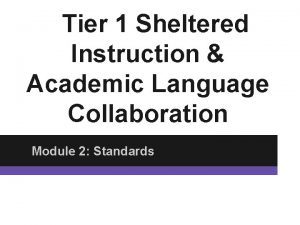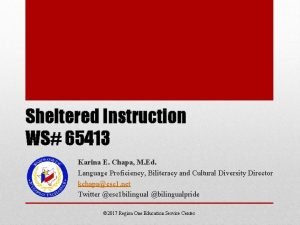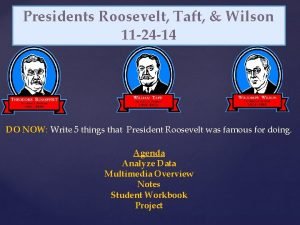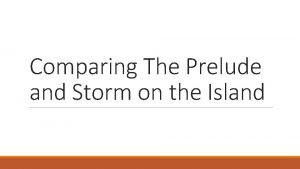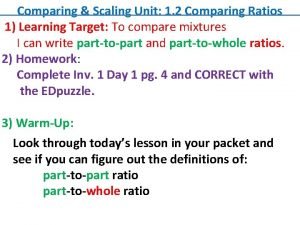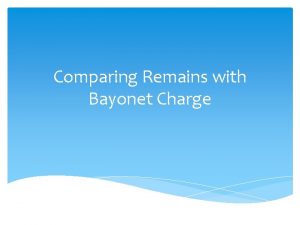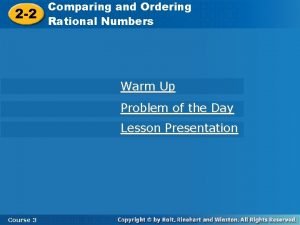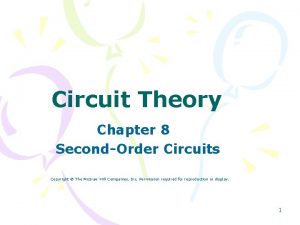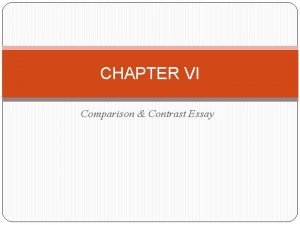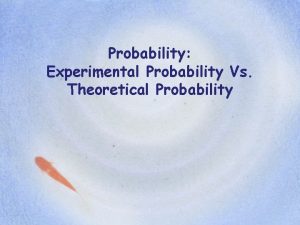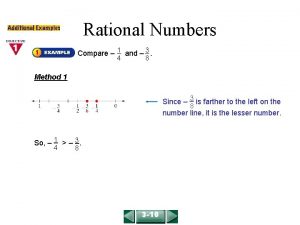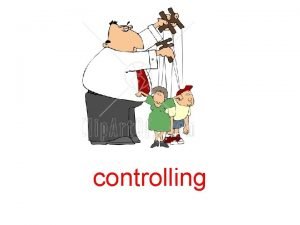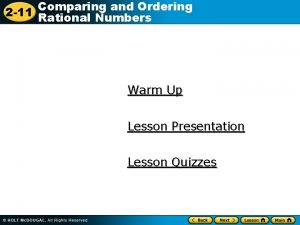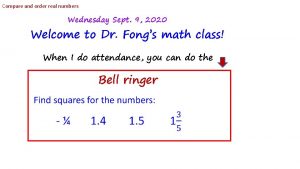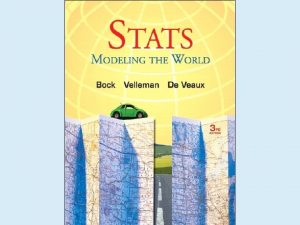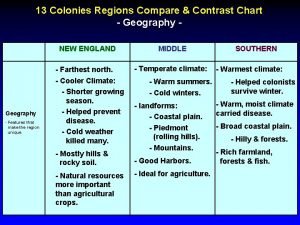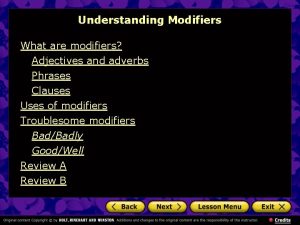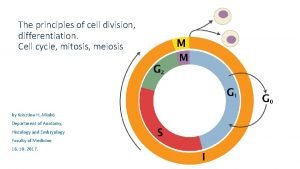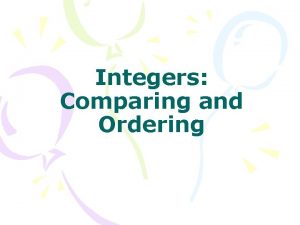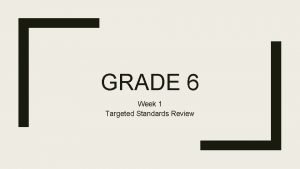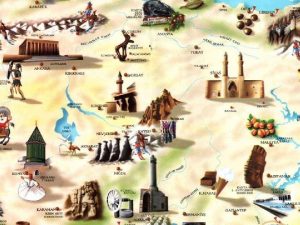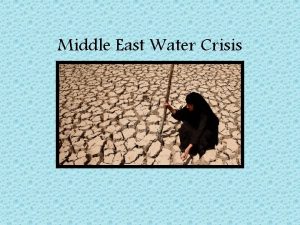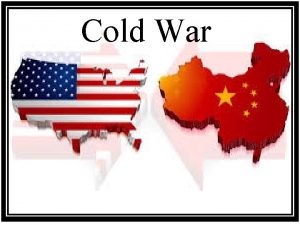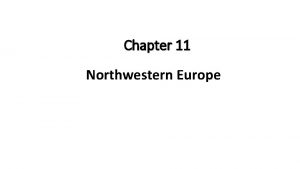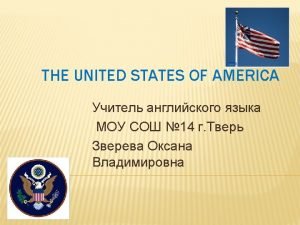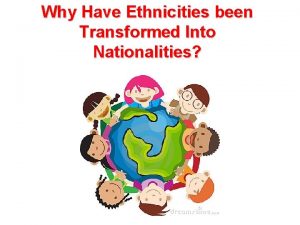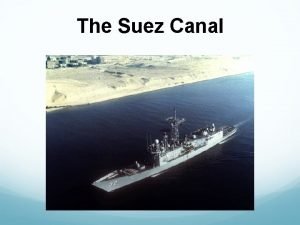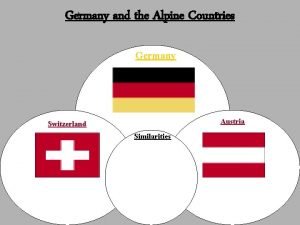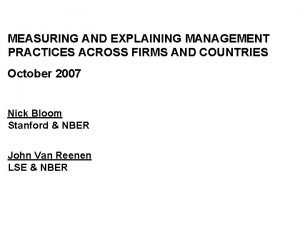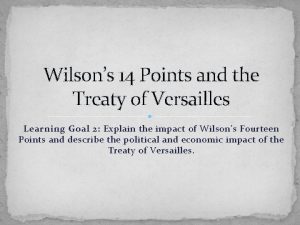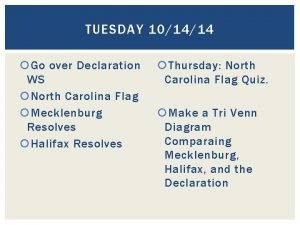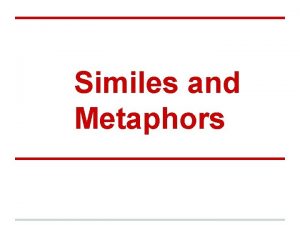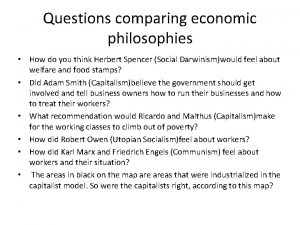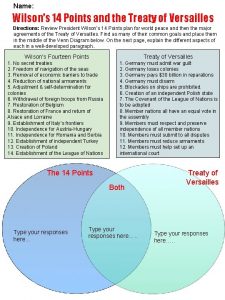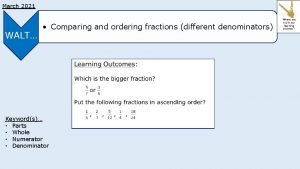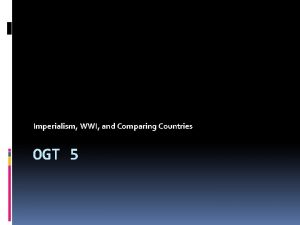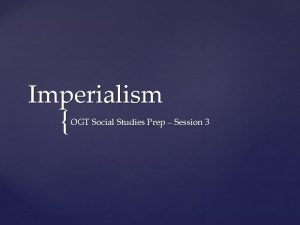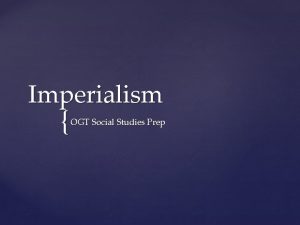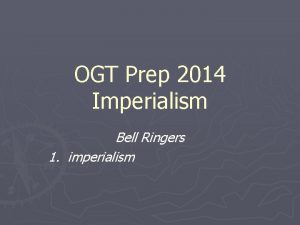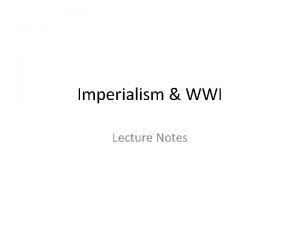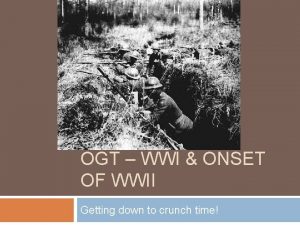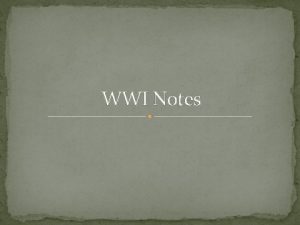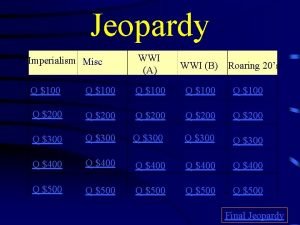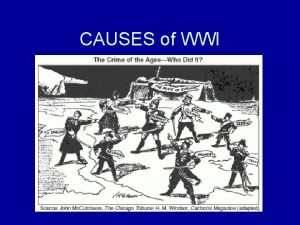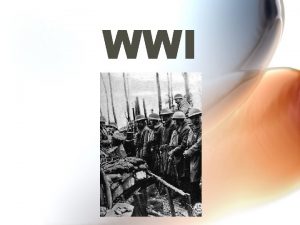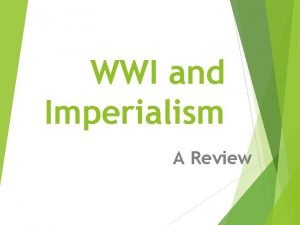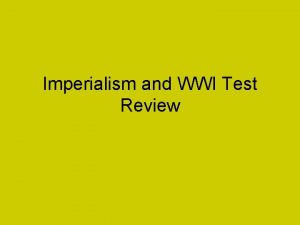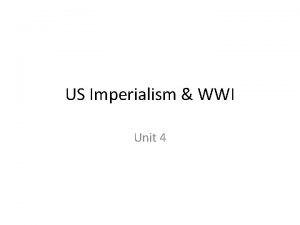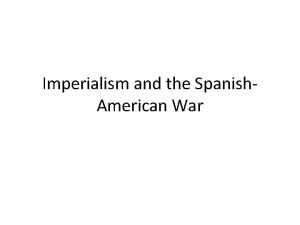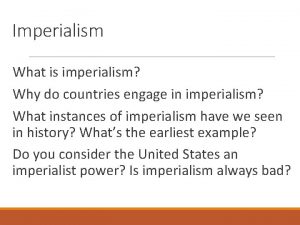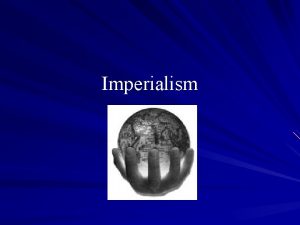Imperialism WWI and Comparing Countries OGT 5 IMPERIALISM















































































































- Slides: 111

Imperialism, WWI, and Comparing Countries OGT 5

IMPERIALISM

# 1 Imperialism: building of empires; one country taking over other country for raw materials and a place to trade goods

# 2 Imperialism changes the economic, environmental, social, and political systems of the natives

# 3 Colonizers believed they were superior to the natives and needed to civilize the world.

# 4 The colonists were often forced to assimilate (to make similar to) the colonizer’s culture.

# 5 indigenous people: native people

# 6 Africa was carved up by the Europeans countries during the 16 th-19 th century.

# 7 China was carved up into “spheres of influence” or special areas in which European countries demanded trading rights and other privileges.

# 8 U. S. demanded equal trading rights in China: “Open Door Policy. ”

# 9 Boxer Rebellion: In 1900 Chinese people organized to kill all foreigners but were defeated.

# 10 The Chinese Revolution: In 1911, he imperial government of China was overthrown and a democracy was set up.

# 11 The democracy of China was overthrown in 1949 by a communist regime led by Mao Zedong.

# 12 Japan was isolated until a fleet of ships commanded by Commodore Perry (U. S. ) arrived.

# 13 Japan was worried that it would be taken over so it chose to modernize itself.

AMERICAN IMPERIALISM:

# 14 By the 1880 s, the United States was manufacturing more goods and growing more food than could be sold at home.

# 15 Gradually, the United States began to break into world markets previously controlled by European nations.

# 16 Manifest Destiny also set the stage for new American interests in overseas markets and territories.

# 17 Technology played an important role in America’s expansion.

# 18 Steamships and telegraphs were a link to the world beyond broad oceans.

# 19 The United States did not want other nations taking control of strategic locations that could be sued for naval bases or steamship coaling stations.

# 20 The Spanish-American War (1898) signaled the emergence of the U. S. as a world power.

# 21 Cuba fought for its independence from Spain in 1895. The revolt resulted in much bloodshed and serious damage to the Cuban economy, which included a great deal of American investments.

# 22 In order to protect American interest, many politicians looked toward the Monroe Doctrine, which stated that the United States would not tolerate European intervention in the Americas.

# 23 The U. S. insisted that Spanish grant Cuba its independent and then leave, but Spain refused.

# 24 In 1898, the U. S. Navy sent the warship Maine to Cuba to protect American property and citizens. The ship exploded and sank in Havana Harbor. The explosion which was probably an accident was blamed on the Spanish.

# 25 yellow journalism: sensational newspaper stories mostly exaggerated started the war.

# 26 America annexed Philippines, Guam, American Samoa, and Puerto Rico as American colonies and established informal control over Cuba.

# 27 In 1898, the U. S. Congress also voted to annex Hawaii—a convenient coaling station for ships on the way to Japan or China

# 28 To ensure American success in the struggle for world markets, Theodore Roosevelt created a new foreign policy that favored using military power to protect national interest called the big-stick diplomacy: “Speak softly and carry a big stick. ”

# 29 To protect U. S. merchant ships, Roosevelt added modern steam-powered warships to the navy’s growing fleet and supported the Open Door Policy.

# 30 In 1905, U. S. secured control over a strip of land in Panama to build the Panama Canal, connecting the Pacific and Atlantic Ocean which boosted U. S. trade and naval influence.

# 31 Roosevelt Corollary to the Monroe Doctrine- the U. S. had the right to use “international police power” in Latin America.

# 32 Not everyone agreed with American expansion. Anti-imperialists believed the Unites States should not maintain armies in foreign countries, but should instead the support of the right of self-rule.

World Discrimination

# 33 perspective: how you view something

# 34 oppression—not having rights

# 35 genocide: the deliberate killing of a group of people

# 36 All indigenous peoples of an area have been subject to oppression and/or genocide

# 37 The Spanish Conquistadores in Latin America: Columbus and other explorers were looking for gold; forced natives in slavery among other atrocities

# 38 Armenian Massacre(1915 -1916) A Christian minority that was killed by the Turkish Ottoman Empire

# 39 The Holocaust: 1941 -1945: 6 million Jews and millions of others were exterminated by the Nazis in WWII

# 40 Communist Purges: Stalin exterminated dissenters, intellectuals, and various ethnic groups in the Soviet Union after the Communist Revolution

# 41 Ethnic Cleansing in the Balkans: Christian Serbs began murdering Muslims in Bosnia and Kosovo after the collapse of Communism. NATO (North Atlantic Treaty Organization) forces finally intervened to stop the slaughters

# 42 Tutsi Genocide: In 1994 in Rwanda, the Hutudominated army massacred close to half a million of the Tutsi minority.

# 43 Massacre of the Kurds: In Iraq, Saddam Hussein used poison gave on the Kurdish minority.

WWI: 1914 -1918

# 44 Causes: nationalism, imperialism, militarism, alliances, and an assassination.

# 45 nationalism: a belief that each “nation” or ethnic group should have its own country and government (Italy and German)

# 46 Empires such as Austria-Hungary feared being split apart into smaller, separate nation -states by the different ethnicities.

# 47 militarism: the development of new methods of warfare based on conscription (draft), rifles, and railroads led to the glorification of military power and a greater dependence on military leaders who believed new weapons made it safer to attack than it was to wait to be attacked.

# 48 alliances: countries that have decided to help each other in the case of war

# 49 Direct Cause: Archduke Franz Ferdinand of Austria-Hungary was assassinated by a Serbian nationalist. Austrians, believing Serb officials had helped the assassins, invaded Serbia. The incident set off a chain reaction drawing Europe’s major powers into war.

# 50 new weapons and fighting styles: machine guns, poison gas, submarines, airplanes, and trenches protected by barbed wire

# 51 U. S. wanted to remain neutral-extension of Monroe Doctrine.

# 52 German submarines began attacking American ships bringing supplies to Britain and France—sinking of the Lusitania

# 53 The German government sent a telegram (Zimmerman Note) to Mexico saying that if Mexico helped German by attacking the United States in return for regaining Texas, New Mexico, and Arizona.

# 54 As a result of the use of submarine warfare and the Zimmerman Note, the U. S. enters the war on the side of the Allied Powers.

# 55 Allied Powers: Great Britain, France, Russia, and the U. S.

# 56 Central Powers: Germany, Austria-Hungary, and the Ottoman Empire

# 57 conscientious objectors: people who believe war is wrong especially for religious reasons; Quakers and Jehovah Witnesses)

# 58 balancing individual rights against the common good (the good of the nation)- it would be wrong to force people to fight the war if it violated their religious rights. The draft law exempted them from combat, but not from military services; driving ambulance, office clerk, cook

# 59 End of WWI: millions of people were killed or injured; people in many parts of the world suffered from famine and malnutrition; complete devastation of the geography of Europe.

# 60 The Treaty of Versailles: terms of peace; especially harsh to Germany which will lead to WWII Austria Hungary: split apart including Hungary, Czechoslovakia, and Yugoslavia. Ottoman Empire (Turkey): lost its Arab possessions in the Middle East; these territories were made into French and British colonies

# 60 Continued Germany: A weak democracy called the Weimer Republic was set up. lost territory along its borders to France and Poland (Alsace-Lorraine) forced to give up all of its overseas colonies. disarmament: Germany lost its navy, and its army was reduced was forced to accept blame for having started WWI was required to pay huge reparation or payments for damages to Great Britain and France

# 61 League of Nation was proposed by President Wilson as one of his 14 Points (list of American goals for the world to follow after the war).

# 62 The goal of the League of Nation to prevent futures wars.

# 63 The League of Nations was weak. The U. S. did not join—return to isolationism Russia was not allowed to join due to the Russian Revolution.

#64 Russian Revolution: war helped the overthrow of the Tsar by a revolutionary group led by Lenin who campaigned for “Peace, Bread, and Land. ” In November 1917, the Bolsheviks seized power, withdrew from war, and established a Communist dictatorship called the Soviet Union. Russia gave up control of Poland, Finland, and the Baltic States, all of which became new nations.

Between Wars

# 65 Roaring Twenties: good times of calm and prosperity. rise of automobile and other industries (steel, glass, rubber) more efficient production methods (Henry Ford and mass production); mass consumption: advertising stimulated demand, while workers with higher wages and more leisure time had greater purchasing power retailers developed programs for installment purchases

# 66 18 th Amendment: Prohibition: cannot make, sell, or consume alcohol

# 67 19 th Amendment: women’s suffrage (right to vote)

# 68 21 st Amendment: Repeal Prohibition

# 69 After WWI, the government stopped its wartime spending and the soldiers returned home looking for jobs.

# 70 The Great Migration: The wave of African American migrants from the rural South who were sharecroppers during the early 20 th century (1900 s) who moved urban north seeking better jobs and housing; the heaviest concentrations occurred during World War I and World War II when more jobs were available for women and ethnic groups

# 71 The Great Migration will lead to less workers available in the South, but contribute to the overcrowding population and competition for jobs in the city.

# 72 Harlem Renaissance: “The Jazz Age”: The flourishing literary, musical, and artistic expression of African Americans in Harlem in the 1920 s due to the Great Migration

# 73 Red Scare: led to arrest of radicals (communists) accused of plotting to overthrow the government; Sacco and Vanzetti, two immigrants, were executed for committing murder to obtain funds for an anarchist revolution, despite insufficient evidence.

# 74 Rise of nativism—dislike of foreigners; revival of KKK which opposed foreigners, blacks and Jew

# 75 Immigration Acts: limited immigration from Southern and Europe and from Asia

DEMOGRAPHIC DATA

# 76 demographic data: data related to population

# 77 population density: how many people live in a given are

# 78 life expectancy: how long people live

# 79 birth rate: the number of people born per year in a country

# 80 Death Rate: the number of people who die each year in a country

# 81 infant mortality rate: the number of babies who die per 1, 000 live births

# 82 literacy rate: the percentage of people who can read and write

# 83 standard of living: economic level achieved by those living in a nation (how well people live)

# 84 GDP: (Gross Domestic Product); the measure of the size and wealth of a country's economy

# 85 Per Capita Income: reflects the amount of money earned in a year in that nation by an average person

Types of Nations

# 86 Developed Nation Characteristics: advanced economy high standard of living, low birth rates low death rates low infant mortality rate high literacy high per capital income high GDP high, % of people attending colleges and universities large number of doctors and hospitals serving the population, greater number of automobiles, telephones, and other technology, more productive workers because they using machinery and high-tech tools. Ex. U. S. , Germany, Britain, and France

# 87 Developing Nation Characteristics: less advanced technology lower standard of living, traditional economy or working towards a higher economy high birthrate, high death rate high infant mortality rate lower literacy, lower per capita income lower % of people attending colleges and universities small number of doctors and hospitals available to serve the population. Workers are engaged in subsistence farming (farming for own needs) using primitive tools. Lacking investments, workers are less productive and less competitive.

ANALYZING DATA BASED QUESTIONS

# 88 maps: to interpret maps you need to know how to use the map’s legend (key), compass rose (direction finder) and scale (distance).

# 89 historical map: title and legend will tell you what the map represents; read it like any other map, except you need to pay close attention to features like the names of countries, political borders, and the location of cities, since these are often different from what they are today.

# 90 pie chart: circle graph; A graph divided into sections to show relationships between a whole and its parts; shows percentage= 100%; c an’t get total number unless it tells you somewhere else!

# 91 line graph: consists of a series of points connected by a line and shows changes over time

# 92 bar graph: made up of parallel bars of different lengths used to make comparisons; each bar represents a quantity (number or %)

# 93 table: used to organize large amounts of information so that it is easier to read; pay attention to headings of columns or rows

# 94 time line: shows a group of events arranged along a line in the order in which they occurred related to a particular topic; a lightning bolt in the time line shows a skip in time that is not accurately shown

# 95 Photographs, Paintings, and Drawings: can show people looked, dressed, and lived; use these clues to figure out what time period is being represented and to draw a conclusion

# 96 Political Cartoons: expresses an opinion about a political topic or issue; normally criticizes government or politics and wants to persuade readers to adopt a particular point of view; pay attention to the size of objects, facial expressions, exaggerations, and words spoken by characters, symbols (an object that stands for something else); can be funny, but used to make a point

# 97 Quotations and Documents; try to understand the viewpoint of the author; they may have different attitudes than today. Keep in mind to figure out meaning: - Who is the author or speaker? - What time period is represented? - What is thesis of the document? - What connections can you make to other things?

# 98 Population Density Map: uses patterns represented to show many people live in an area

# 99 Dot population map: uses dots to indicate where major towns and cities are located

# 100 Population Pyramids: an age structure diagram is a graphical illustration that shows the distribution of various age groups in the population of a country or region. Ideally, the shape should be a pyramid when the population of the area is healthier

# 101 Human Development Index (HDI): ranks the world's nations in terms of the overall quality of life for people in each country. It analyzes information such as life expectancy, adult literacy, educational levels, and income to determine a country's ranking.
 Ogt practice test
Ogt practice test How many countries were involved in wwi
How many countries were involved in wwi Is great britain a country
Is great britain a country Imperialism definition ww1
Imperialism definition ww1 Old imperialism vs new imperialism chart
Old imperialism vs new imperialism chart New imperialism motives
New imperialism motives Neutral countries in ww1
Neutral countries in ww1 Ww1 webquest answer key
Ww1 webquest answer key Sides of wwi
Sides of wwi Ww1 causes
Ww1 causes Impact of wwi
Impact of wwi New technology in wwi
New technology in wwi Causes of wwi (mania)
Causes of wwi (mania) New technology in wwi
New technology in wwi The chain of friendship cartoon
The chain of friendship cartoon Simulateries
Simulateries What caused wwi
What caused wwi Cause of ww1
Cause of ww1 Wwi background
Wwi background M.a.n.i.a world war 1
M.a.n.i.a world war 1 First world war conclusion
First world war conclusion Ww1 jeopardy
Ww1 jeopardy Weapons of wwi
Weapons of wwi Nationalism wwi
Nationalism wwi Wwi
Wwi Main long term & immediate causes of wwi
Main long term & immediate causes of wwi Airplane wwi
Airplane wwi Crash course ww1
Crash course ww1 What was the spark that ignited world war 1
What was the spark that ignited world war 1 What does the zimmerman note say
What does the zimmerman note say Eastern front line ww1
Eastern front line ww1 4 causes of ww1
4 causes of ww1 4 causes of ww1
4 causes of ww1 Causes of ww1
Causes of ww1 Where was the british naval blockade ww1
Where was the british naval blockade ww1 Ww1 alliance cartoon
Ww1 alliance cartoon Wwi
Wwi Propaganda
Propaganda Wwi
Wwi Wwi simulation
Wwi simulation Mania acronym for causes of wwi
Mania acronym for causes of wwi Why did the us enter wwi
Why did the us enter wwi Were critics of wwi anti-american
Were critics of wwi anti-american Compare and contrast hinduism and buddhism
Compare and contrast hinduism and buddhism Kamikaze poem analysis
Kamikaze poem analysis Difference between permutation and combination
Difference between permutation and combination Representing comparing and ordering decimals
Representing comparing and ordering decimals Complete the concept map
Complete the concept map Comparing fractions and decimals
Comparing fractions and decimals How do you compare and order integers
How do you compare and order integers Meaning of compare and contrast
Meaning of compare and contrast How to identify bases
How to identify bases Lesson 8 comparing series and parallel rlc circuits
Lesson 8 comparing series and parallel rlc circuits Karina is writing a paragraph comparing and contrasting
Karina is writing a paragraph comparing and contrasting Karina is writing a paragraph comparing and contrasting
Karina is writing a paragraph comparing and contrasting Comparing progressive presidents
Comparing progressive presidents Cvs and amniocentesis venn diagram
Cvs and amniocentesis venn diagram When comparing human and sheep brains
When comparing human and sheep brains Storm on the island and the prelude comparison
Storm on the island and the prelude comparison Comparing and scaling unit test
Comparing and scaling unit test Key themes in bayonet charge
Key themes in bayonet charge How to compare and order rational numbers
How to compare and order rational numbers Lesson 8: comparing series and parallel rlc circuits
Lesson 8: comparing series and parallel rlc circuits Signal words comparison and contrast
Signal words comparison and contrast Plant vs animal cells venn diagram
Plant vs animal cells venn diagram Compare and contrast athens and sparta
Compare and contrast athens and sparta Experimental vs theoretical probability
Experimental vs theoretical probability Legal moves for simplifying and comparing expressions
Legal moves for simplifying and comparing expressions Make an analogy comparing energy and money
Make an analogy comparing energy and money Lesson 3-3 comparing and ordering rational numbers
Lesson 3-3 comparing and ordering rational numbers Monitoring comparing and correcting work is part of
Monitoring comparing and correcting work is part of Compare and order fractions
Compare and order fractions Comparing lines and linear equations
Comparing lines and linear equations Lesson 3-3 comparing and ordering rational numbers
Lesson 3-3 comparing and ordering rational numbers Ordering real numbers
Ordering real numbers Understanding and comparing distributions
Understanding and comparing distributions Comparing colonial regions chart
Comparing colonial regions chart 5 differences between memorandum and business letter
5 differences between memorandum and business letter Comparing and classifying
Comparing and classifying Kolateral terbuka dan tertutup
Kolateral terbuka dan tertutup Modifiers with adjectives
Modifiers with adjectives Diploten
Diploten Comparison and contrast
Comparison and contrast Mitosis
Mitosis Mitosis my toe sis
Mitosis my toe sis Comparing and ordering integers
Comparing and ordering integers Chris and jenny are comparing two similar punch recipes
Chris and jenny are comparing two similar punch recipes Dna v rna venn diagram
Dna v rna venn diagram Comparing merchandising and manufacturing activities
Comparing merchandising and manufacturing activities The seven continents and their countries
The seven continents and their countries Why are some countries rich and others poor
Why are some countries rich and others poor Gope
Gope Difference between developing and underdeveloped countries
Difference between developing and underdeveloped countries Economics for leaders
Economics for leaders Communist and capitalist countries cold war
Communist and capitalist countries cold war Northwestern european countries
Northwestern european countries Asia europe south america
Asia europe south america Listen and repeat the names of the countries
Listen and repeat the names of the countries Stateless nation
Stateless nation Mdc more developed countries
Mdc more developed countries Suez
Suez Germany and the alpine countries
Germany and the alpine countries Management practices across firms and countries
Management practices across firms and countries Treaty of versailles vs wilson's 14 points
Treaty of versailles vs wilson's 14 points Comparing declarations venn diagram
Comparing declarations venn diagram Simile for boring
Simile for boring Two figures of speech that involve comparisons are
Two figures of speech that involve comparisons are Comparing economic philosophies worksheet answers
Comparing economic philosophies worksheet answers 14 points vs treaty of versailles venn diagram
14 points vs treaty of versailles venn diagram Ordering fractions with different denominators
Ordering fractions with different denominators Literary devices in the jungle
Literary devices in the jungle Comparing two things not using like or as
Comparing two things not using like or as

